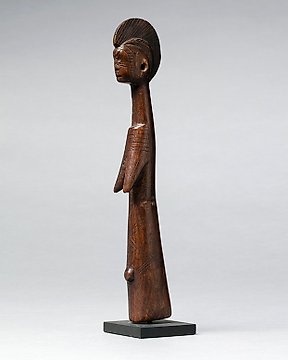
Bagirmi - Mossi - Burkina Faso
Nr 83440679

Nr 83440679

A Mossi mask from Burkina Faso in Karan-Wemba style, probably Yatenga related, composed of two levels, the lower part with an oval-shaped face mask and the upper part with a standing woman, the vertical middle ridge is framed by two circular holes carved to give the wearer visibility, the arched mask-body is decorated with geometric patterns; the woman on top stands with knees slightly bent, protruding navel with scarification around it, and three vertical scarifications running from the navel to the sternum; her breasts are conical, her arms hand straight on her sides; Her neck leads to a face with scarifications that has two small eyes, a pinched nose and full round lips, the ears are prominent and she has a crested hair. Signs of ritual use. Certificate of Provenance.
“ […] Mossi Masks are owned by a clan (group of people claiming descent from the same ancestor) and are used in various ceremonies, including initiations, funerals, and annual year-end sacrifices. The masks represent the spirits of familiar animals and clan’s ancestor spirits or serve as a guardians of fruits. Every member of a clan is connected to the animal that their clan’s mask depict. The animal is involved in founding myths of the clans and members of a clan cannot kill their clan’s animal. Masks are named after the animal a mask represents, prefixed by the word “wan-“. For example a gazelle mask will be named “wan-nyaka”. The masks are commonly accompanied by a costume made of blackened fibres from the hibiscus plant called a bind. Young men who are educated in the meanings of the mask are those chosen to wear them, and they are also known by the name wango.”
Source: Pacific Lutheran University, Washington.
Jak kupować w serwisie Catawiki
1. Odkryj coś wyjątkowego
2. Złóż najwyższą ofertę
3. Dokonaj bezpiecznej płatności